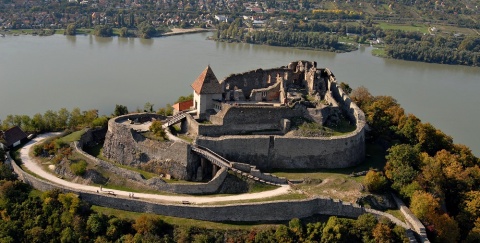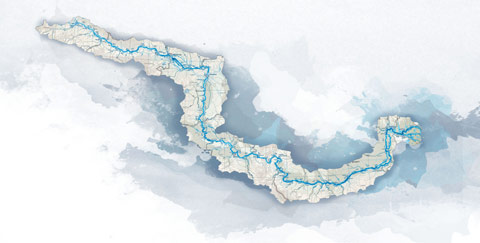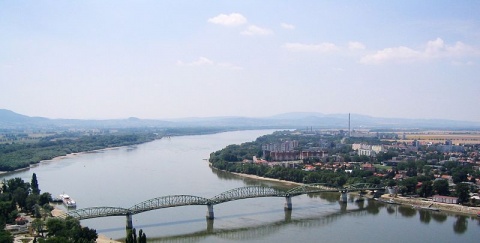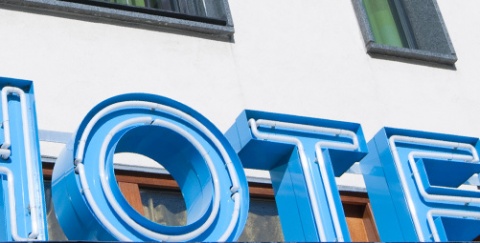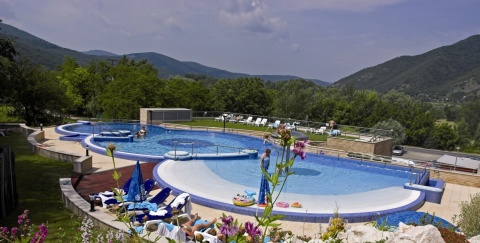
Visegrád is a small castle town on Danube. It has city rights since 2000. The name Visegrád is of Slavic origin, its meaning is "upper castle" or "upper fortification”.
At this strategically most important place of the Danube Bend, Romans built their Castrum Pons navatus on Sibrik Hill, in the 4th century AD, high above Danube. Excavations brought to light the praetorium (house of the commander). In the 10th and 11th century AD, a new fortification was built in the form of a castle, to protect the new, young Hungarian state. The first mentioning of Visegrád happened in 1009 AD. All went down during the Mongolian (Tatar) invasion of 1242.
Sibrik Hill is close to the famous citadel of Visegrád, a double castle system. Upper Castle of Visegrád, after the Tatar invasion, by King Bela IV, around 1250, had a triangular shape and three towers. In the 14th century, it was extended and became a Royal palace, when King Charles I of Hungary made Visegrád, his hometown, the royal seat of Hungary, in 1325 (other sources: 1323). In 1335, Charles hosted here a two month long congress with Bohemian King John of Luxembourg, and Polish King Casimir III to discuss an alliance against Habsburg-Austria. Another congress happened here in 1338.
Around 1400, Holy Roman Emperor and Hungarian King Sigismund ordered the construction of a third wall and enlarged the palace buildings, but moved as well the Royal seat to Buda, between 1405 and 1408. Legendary King Matthias Corvinus of Hungary renovated the interior of the Royal Palace. It became his early Renaissance style summer palace in the medieval citadel, which today attracts thousands of visitors. The Upper Castle served as a treasury for the Royal insignia, until 1526, when the fatal Battle of Mohács changed everything (read more in section Mohács of City Breaks). In 1544, Ottoman troops conquered the Upper Castle for the first time. During 1595 – 1605, a successful re-conquer took place, Ottoman presence lasted until 1685. After 1685, there was no military use anymore, for the Upper Castle. Today, it is open for visitors.
The Lower Castle is a result of the complex fortification system that connects the Upper Castle with the Danube. The center of the Lower Castle is built by the so called Salomon Tower (Hungarian: Salomon torony; opening hours: May – Sep, Tue – Sun 9.00 – 17.00, only), a residential tower of the 13th century. In the 14th century, new fortification walls were built. But these could not stand the Turkish attack of 1544 – parts of the Salomon Tower were destroyed. It is said, that Vlad Tepes aka Dracula was imprisoned here, between 1462 and 1477 (read more in section Giurgiu, Sightseeing in and around cities of Giurgiu and Bucharest). The renovation of the tower started in 1870 and lasted until 1960. Today, this is the tower house exhibitions of the King Matthias Museum (Hungarian: Mátyás Király Múzeum) of Visegrád. These include the reconstructed Gothic fountains of the Royal Palace, Renaissance art works in Visegrád, and the town history.
The first Royal Palace dates back to King Charles I of Hungary and 1325. In the second half of the 14th century, it was enlarged by his son, King Louis I of Hungary. In the late 14th century, King Louis and his successor Sigismund of Luxembourg dismantled the major part of the early buildings and ordered a new palace complex. The ruins of it (123 x 123 m) can still be seen. In 1424, a garden in the north and a Franciscan friary in the south, were added. 1477 – 1484, famous King Matthias Corvinus ordered the complete reconstruction of the palace in late Gothic style, while the decoration was in Italian Renaissance architectural style, used for the first time outside Italy. After 1544, the Royal palace was in ruins and totally covered with earth, until the start of the 20th century. Excavations started in 1934 and are still ongoing. The reconstructed palace can be visited today and houses exhibitions and artifacts of the former palace can be seen.
The most attractive town (1.850 inhabitants; Hungarian name: Fellegvár; former German name: Plintenburg) became internationally recognised, in 1991, when the Declaration of Visegrád was signed. It declared to open the later on, so called, Visegrád Group members (Hungary, Czech Republic, Slovakia, Poland) to Europe. The group, sometimes also called Visegrád Four, or V4, is still meeting, with annual changing presidency.
Location: City of Visegrád is 46 km north of Budapest (GPS N 47°46' 47.18" E 18°58'57.94") and about. 15 km west of the city of Vác. It can be reached by car, bus or train. There are regular tourist excursion offers from Budapest, even on a daily basis. Trains leave from Budapest Nyugati railway station to Nagymaros/Visegrád (up to 60 minutes). There is direct bus service from Budapest, Újpest Városkapu M (south side) to Visegrád (around 80 min.) You can also go by boat to Visegrád. There is a hydrofoil service of Mahart from/to Budapest (Apr – Sep, only).
DANUBE.TRAVEL has no control over the website content generated by users and/or visitors, neither such content represents a statement, opinion, recommendation or rating by DANUBE.TRAVEL. For further information please refer to DANUBE.TRAVEL – General Website Terms and Conditions of Use.
 EN
EN DE
DE
